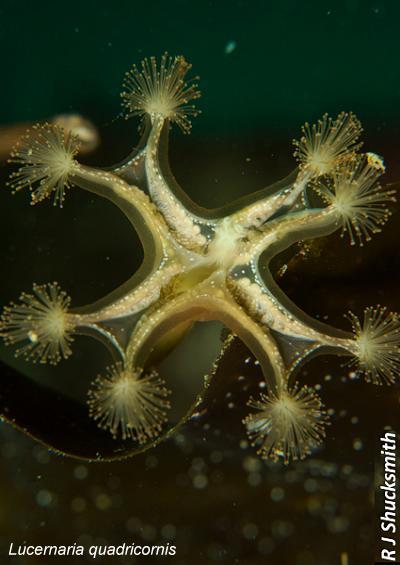STAUROMEDUSAE UK
An online guide to the Stalked jellyfish (Stauromedusae) found
around the coastal waters of the United Kingdom and Ireland.
Includes notes on their identification, and where and how to find them.
Lucernaria fascicularis, Fleming in Wern. Mem. ii. 248, pl. 18, fig- 1, 2.
Flem. Brit. Anim. 499. Templeton in Mag. Nat. Hist. ix. 304. Blainv.
Actinolog. 664. ----Lucernaire fasciculaire, Lamouroux in Mem. du Mus. ii. 470.
Hab. Common in Zetland, where "it is chiefly found on the leaves of Fucus digitatus and F. esculentus, which grow in deep water," Fleming.
"Found on the coast at Donaghadee, after a strong easterly gale, adhering to a fragment of Fucus serratus," Templeton.
" Colour dark brown; peduncle cylindrical, flexuous, wrinkled, with a narrow base; body bell-shaped, subquadrangular, concave; margin divided into four pairs of arms, concave within ; mouth central, tubular, consisting of a loose membrane, four notched at the tip, and also expanded, circular, or striated at the pleasure of the animal; the inside with numerous white filaments."—" The animal contracts itself into various shapes. It moves the tentacula very quickly, especially if muddy water is poured upon it. Although I have kept it alive several days, I have never observed it in an upright position. It in general hangs downwards, as expressed in the figure, sometimes, however, it is nearly horizontal." Fleming.
" When at rest, it assumes very much the form of a common drinking-glass, and is exceedingly conspicuous from its beautiful rose tint." Templeton.
Ref: A History of the British Zoophytes by George Johnston M. D. Edin. 1838.
Article refers to Lucernaria quadricornis.
